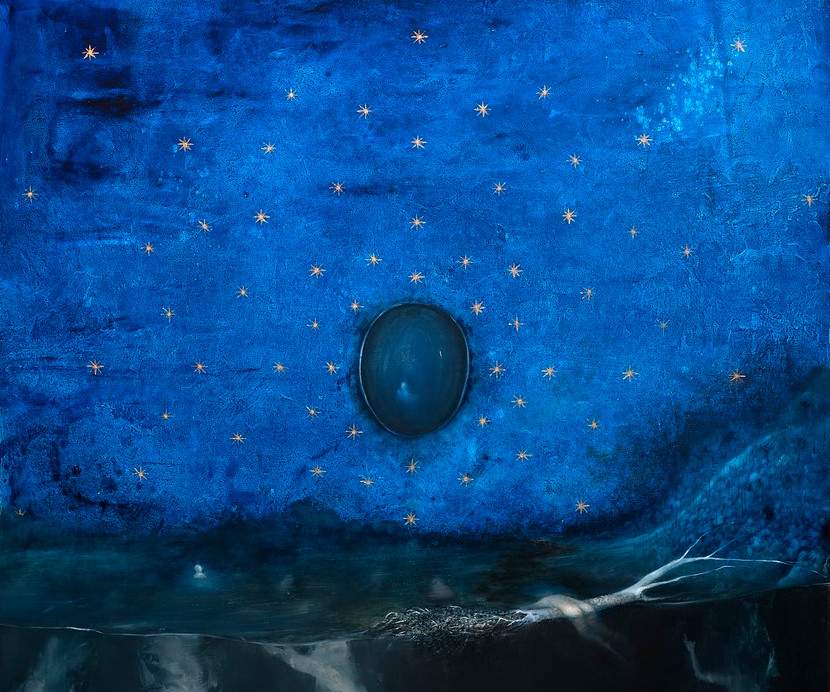From Oct. 30, 2021 to Jan. 30, 2022, the Museo Eremitani in Padua presents the contemporary art exhibition A riveder le stelle, organized by the Cultural Department of the City of Padua, in collaboration with Antonio Menon’s The Bank Contemporary Art Collection and with the support of the Fondazione Cassa di Risparmio di Padova e Rovigo. The exhibition is part of the celebrations of the 700th anniversary of Dante’s death and is curated by Barbara Codogno; it will create an ideal dialogue with Giotto’s frescoes, recently included in the UNESCO World Heritage List as Padova Urbs Picta.
A riveder le stelle intends to pay homage to both Dante and Giotto, the two pillars of 14th-century culture who were the bearers of a revolution in both literature and art, through contemporary Italian figuration from The Bank Contemporary Art Collection in Bassano. It is precisely the stars that are the ultimate meeting point between the two authors: Giotto’s stars of the Scrovegni Chapel and those invoked by Dante in the last verse of theInferno, when with Virgil, after overcoming the darkness, Dante contemplates the starry sky.
The atmospheres narrated by Giotto and Dante will be evoked in the exhibition by about forty works, some of them created especially for the occasion by established Italian artists also known internationally. Among others are Agostino Arrivabene, Saturno Buttò, Alfio Giurato, Maurizio L’Altrella, Paolo Maggis, Vittorio Marella, Sergio Padovani, Alessandro Papetti, Luca Pignatelli, Desiderio Sanzi and Santiago Ydanez, displayed in the newly renovated and refurbished temporary exhibition rooms of the Eremitani Museum. The exhibition consists of about forty works, some of which were created especially for the occasion by established Italian artists who are also known internationally. These figurative works are thus placed in dialogue with the existential themes that Giotto frescoes in the Scrovegni Chapel and those translated by Dante in The Comedy.
“Certainly the relationship between Giotto and Dante is controversial, and it is unlikely that they ever met,” explains the City of Padua’s culture alderman Andrea Colasio. “No less controversial is the relationship between Padua and Dante, which instead the Poet visited, and which he identified in the Divine Comedy as a place of evil, placing as many as two Paduans among the damned in Canto XVII of the Inferno: the first is precisely Reginaldo Scrovegni as he was judged to be a loan shark, the second Vitaliano del Dente, to whom Dante has the Scrovegni himself foretell damnation in Hell. Dante’s screeds also hit Padua for another important protagonist of the time, Pietro D’Abano, who was not in favor of free will and who had certainly collaborated with Giotto on the frescoes of the Palazzo della Ragione.”
Divided into sections with cross-references to details of the frescoes in the Scrovegni Chapel, the exhibition “is not meant to be didactic,” explains the curator, “much less hagiographic or passatist, rather evocative and evocative, yet remaining faithful to the path of light traced by both Dante and Giotto and thus ferrying the viewer to the relief of rebirth indicated by the stars.”
The exhibition’s guiding image, by Sergio Padovani (Modena, 1972), is Open Stars: a painting that, with its development on an ascending scale, evokes Dante’s three Cantiche. Giotto’s Cross dialogues with Federico Guida’s La mia prima croce (Milan, 1969), while the work Si fece buio su tutta la terra by Nicola Nannini (Bologna, 1972) was chosen to evoke the Last Judgment. The Dantean universe of Cerberus and the beasts lives again in the works of Maurizio L’Altrella (Milan, 1972). Lucifer is the protagonist of another work by L’Altrella, La bestia luminosa, but also of Saturno Buttò’s (Venice, 1957) ironic reinterpretation.The path of rebirth is represented by artists who lead into the waiting zone of Limbo, such as Alfio Giurato (Catania, 1978), Luca Pignatelli (Milan, 1962) and Alessandro Papetti (Milan, 1958), concluding the journey in a Paradise where Giotto’s blue is found in the absolute backgrounds of Sergio Fiorentino (Catania, 1973), with bodies resting together, finally pacified, in a consoling embrace.
The exhibition will be open to the public Tuesday through Sunday from 9 a.m. to 7 p.m. Closed on non-holiday Mondays, Christmas, Boxing Day, New Year’s Day.
For info: www.padovamusei.it
Image: Sergio Padovani, Open Stars, detail (2020; oil, bitumen and resin on canvas, 230 x 160 cm)
 |
| A riveder le stelle: contemporary artists pay homage to Dante and Giotto in Padua |
Warning: the translation into English of the original Italian article was created using automatic tools. We undertake to review all articles, but we do not guarantee the total absence of inaccuracies in the translation due to the program. You can find the original by clicking on the ITA button. If you find any mistake,please contact us.